The use of mobile learning applications in higher education institutes
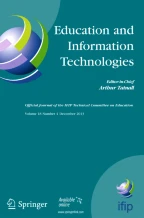
Higher education institutes are continuously exploiting technology to improve the delivery of courses. This paper reviews the use of mobile learning applications in higher education institutes to; i) identify publication trends, ii) types of mobile learning applications used, and iii) categorize the research papers published. The applied method is the Systematic Mapping Study. A Systematic mapping study was conducted using 103 papers retrieved from six different databases. The findings of this mapping study showed an increased research interest in the field and a variety of mobile learning applications used (learning management, vodcast and podcast, game-based learning, collaborative learning, and language learning applications). The published studies are mainly solution-oriented that focus on the use of mobile learning applications. The results were helpful to position future research activities.
This is a preview of subscription content, log in via an institution to check access.
Access this article
Subscribe and save
Springer+ Basic
€32.70 /Month
- Get 10 units per month
- Download Article/Chapter or eBook
- 1 Unit = 1 Article or 1 Chapter
- Cancel anytime
Buy Now
Price includes VAT (France)
Instant access to the full article PDF.
Rent this article via DeepDyve

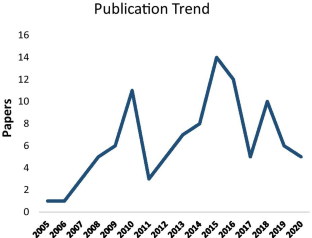
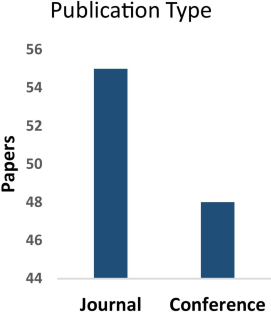
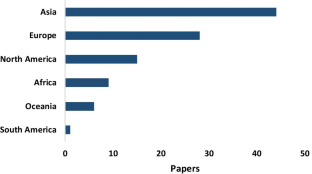
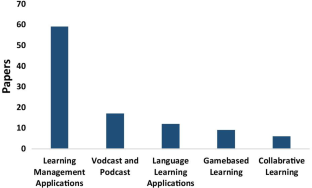
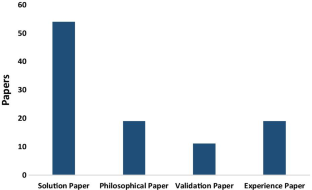
Similar content being viewed by others

Use of Instructional Design, Instructional Strategy, and Learning Theory in Mobile Learning Application Development
Chapter © 2022

The Trends in Mobile Learning
Chapter © 2013

Trends in Mobile Learning: 2010–2017
Chapter © 2019
Explore related subjects
- Artificial Intelligence
- Digital Education and Educational Technology
References
- Al-Emran, M., Elsherif, H. M., & Shaalan, K. (2016). Investigating attitudes towards the use of mobile learning in higher education. Computers in Human Behavior,56, 93–102. https://doi.org/10.1016/j.chb.2015.11.033ArticleGoogle Scholar
- Andrei, T., Vasiu, R., Mihaescu, V., & Andone, D. (2019). Integrating open technologies in the virtual mobility learning hub. Paper presented at the 2161–377X 24–28. https://doi.org/10.1109/ICALT.2019.00016. Retrieved from https://ieeexplore.ieee.org/document/8820897
- Brata, K., Brata, A., & Lukman, E. (2019). Hanasu. Paper presented at the 311–315. https://doi.org/10.1145/3345120.3345155. Retrieved from http://dl.acm.org/citation.cfm?id=3345155
- Castillo, A., Clunie, T., & C., de Clunie, G., & Rodríguez, K. . (2013). A system for mobile learning: A need in a moving world. Procedia, Social and Behavioral Sciences,83, 819–824. https://doi.org/10.1016/j.sbspro.2013.06.154ArticleGoogle Scholar
- Cheung, W. S., & Hew, K. F. (2009). A review of research methodologies used in studies on mobile handheld devices in K-12 and higher education settings. Australasian Journal of Educational Technology, 25(2).
- Crompton, H., & Burke, D. (2018). The use of mobile learning in higher education: A systematic review. Computers and Education,123, 53–64. https://doi.org/10.1016/j.compedu.2018.04.007ArticleGoogle Scholar
- Cross, S., Sharples, M., Healing, G., & Ellis, J. (2019). Distance learners’ use of handheld technologies. International Review of Research in Open and Distance Learning, 20(2). https://doi.org/10.19173/irrodl.v20i2.4040
- Cruz, S., Carvalho, A. A., & Araujo, I. (2015). 1910: A mobile game to relive the implementation of the republic in portugal. Paper presented at the 103–108. https://doi.org/10.1109/SIIE.2015.7451657. Retrieved from https://ieeexplore.ieee.org/document/7451657
- Davies, M. (2014). Using the apple iPad to facilitate student-led group work and seminar presentation. Nurse Education in Practice,14(4), 363–367. https://doi.org/10.1016/j.nepr.2014.01.006ArticleGoogle Scholar
- Diacopoulos, M. M., & Crompton, H. (2020). A systematic review of mobile learning in social studies. Computers and Education,154, 103911. https://doi.org/10.1016/j.compedu.2020.103911ArticleGoogle Scholar
- Duval, E., Sharples, M., & Sutherland, R. (2017). Research themes in technology enhanced learning. Technology enhanced learning (pp. 1–10). Cham: Springer International Publishing. https://doi.org/10.1007/978-3-319-02600-8_1. Retrieved from http://link.springer.com/10.1007/978-3-319-02600-8_1
- Evans, C. (2008). The effectiveness of m-learning in the form of podcast revision lectures in higher education. Computers and Education,50(2), 491–498. https://doi.org/10.1016/j.compedu.2007.09.016ArticleMathSciNetGoogle Scholar
- Fotouhi-Ghazvini, F., Earnshaw, R. A., & Haji-Esmaeili, L. (2009). Mobile assisted language learning in a developing country context. Paper presented at the 391–397. https://doi.org/10.1109/CW.2009.28. Retrieved from https://ieeexplore.ieee.org/document/5279514
- Gan, B., Menkhoff, T., & Smith, R. (2015). Enhancing students’ learning process through interactive digital media: New opportunities for collaborative learning. Computers in Human Behavior,51, 652–663. https://doi.org/10.1016/j.chb.2014.12.048ArticleGoogle Scholar
- Goksu, I. (2021). Bibliometric mapping of mobile learning. Telematics and Informatics,56, 101491. https://doi.org/10.1016/j.tele.2020.101491ArticleGoogle Scholar
- Hashim, A. S., Ahmad, W. F. W., & Ahmad, R. (2011). Mobile learning course content application as a revision tool: The effectiveness and usability. Paper presented at the , 2 184–187. https://doi.org/10.1109/ICPAIR.2011.5976941. Retrieved from https://ieeexplore.ieee.org/document/5976941
- Hoi, V. N. (2020). Understanding higher education learners’ acceptance and use of mobile devices for language learning: A rasch-based path modeling approach. Computers and Education,146, 103761. https://doi.org/10.1016/j.compedu.2019.103761ArticleGoogle Scholar
- James, K. L., Randall, N. P., & Haddaway, N. R. (2016). A methodology for systematic mapping in environmental sciences. Environmental Evidence, 5(1). https://doi.org/10.1186/s13750-016-0059-6
- Kaliisa, R., & Picard, M. (2017). A systematic review on mobile learning in higher education: The african perspective. TOJET: The Turkish Online Journal of Educational Technology, 16(1).
- Krull, G., & Duart, J. M. (2017). Research trends in mobile learning in higher education: A systematic review of articles (2011 – 2015). International Review of Research in Open and Distance Learning, 18(7). https://doi.org/10.19173/irrodl.v18i7.2893
- Kumar, B. A., & Sharma, B. (2020). Context aware mobile learning application development: A systematic literature review. Education and Information Technologies,25(3), 2221–2239. https://doi.org/10.1007/s10639-019-10045-xArticleGoogle Scholar
- Kumar, B., Goundar, M., & Chand, S. (2019). Usability guideline for mobile learning applications: An update. Education and Information Technologies,24(6), 3537–3553. https://doi.org/10.1007/s10639-019-09937-9ArticleGoogle Scholar
- Kumar, B. A., Goundar, M. S., & Chand, S. S. (2020a). A framework for heuristic evaluation of mobile learning applications. Education and Information Technologies,25(4), 3189–3204. ArticleGoogle Scholar
- Kumar, B. A., Sharma, B., & Nakagawa, E. Y. (2020b). Context aware mobile learning: A systematic mapping study. Education and Information Technologies, 1–20.
- Kumar, B. A., & Mohite, P. (2016). Usability guideline for mobile learning apps: An empirical study. International Journal of Mobile Learning and Organisation,10(4), 223–237. ArticleGoogle Scholar
- Liu, G., Kuo, F., Shi, Y., & Chen, Y. (2015). Dedicated design and usability of a context-aware ubiquitous learning environment for developing receptive language skills: A case study. International Journal of Mobile Learning and Organisation,9(1), 49–65. https://doi.org/10.1504/IJMLO.2015.069717ArticleGoogle Scholar
- Martí, M. C., & Ferrer, G. T. (2012). Exploring learners’ practices and perceptions on the use of mobile portfolios as methodological tool to assess learning in both formal and informal contexts. Procedia, Social and Behavioral Sciences,46, 3182–3186. https://doi.org/10.1016/j.sbspro.2012.06.033ArticleGoogle Scholar
- Motiwalla, L. F. (2007). Mobile learning: A framework and evaluation. Computers and Education,49(3), 581–596. https://doi.org/10.1016/j.compedu.2005.10.011ArticleGoogle Scholar
- Neffati, O. S., Setiawan, R., Jayanthi, P., Vanithamani, S., Sharma, D. K., Regin, R., & Sengan, S. (2021). An educational tool for enhanced mobile e-learning for technical higher education using mobile devices for augmented reality. Microprocessors and Microsystems,83, 104030. ArticleGoogle Scholar
- Ng, S. F., Azlan, M. A. K., Kamal, A. N. A., & Manion, A. (2020). A quasi-experiment on using guided mobile learning interventions in ESL classrooms: Time use and academic performance. Education and Information Technologies,25(6), 1–4719. https://doi.org/10.1007/s10639-020-10191-7ArticleGoogle Scholar
- Oyelere, S. S., & Suhonen, J. (2016). Design and implementation of MobileEdu M-learning application for computing education in Nigeria: A design research approach. Paper presented at the 27–31. https://doi.org/10.1109/LaTiCE.2016.3. Retrieved from https://ieeexplore.ieee.org/document/7743148
- Parsazadeh, N., Ali, R., & Rezaei, M. (2018). A framework for cooperative and interactive mobile learning to improve online information evaluation skills. Computers and Education,120, 75–89. https://doi.org/10.1016/j.compedu.2018.01.010ArticleGoogle Scholar
- Parsola, J., Gangodkar, D., & Mittal, A. (2019). Mobile application for storage and retrieval of e-learning videos using hadoop. Paper presented at the 757–762. https://doi.org/10.1109/ICCES45898.2019.9002272. Retrieved from https://ieeexplore.ieee.org/document/9002272
- Petersen, K., Feldt, R., Mujtaba, S., & Mattsson, M. (2008). Systematic mapping studies in software engineering. Paper presented at the 12th International Conference on Evaluation and Assessment in Software Engineering (EASE) 12, 1–10.
- Petersen, K., Vakkalanka, S., & Kuzniarz, L. (2015). Guidelines for conducting systematic mapping studies in software engineering: An update. Information and Software Technology,64, 1–18. https://doi.org/10.1016/j.infsof.2015.03.007ArticleGoogle Scholar
- Schardt, C., Adams, M. B., Owens, T., Keitz, S., & Fontelo, P. (2007). Utilization of the PICO framework to improve searching PubMed for clinical questions. BMC Medical Informatics and Decision Making,7(1), 16. https://doi.org/10.1186/1472-6947-7-16ArticleGoogle Scholar
- Tatnall, A. (2020). Technological innovation in ICT for education. Encyclopedia of education and information technologies (pp. 1692–1705). Cham: Springer International Publishing. https://doi.org/10.1007/978-3-030-10576-1_51. Retrieved from http://link.springer.com/doi.org/10.1007/978-3-030-10576-1_51
- Traxler, J. (2005). Defining mobile learning. Paper presented at the IADIS International Conference Mobile Learning, 261–266.
- Troussas, C., Krouska, A., & Sgouropoulou, C. (2020). Collaboration and fuzzy-modeled personalization for mobile game-based learning in higher education. Computers and Education,144, 103698. https://doi.org/10.1016/j.compedu.2019.103698ArticleGoogle Scholar
- Wieringa, R., Condori-Fernandez, N., Daneva, M., Mutschler, B., & Pastor, O. (2012). Lessons learned from evaluating a checklist for reporting experimental and observational research. Paper presented at the Proceedings of the ACM-IEEE International Symposium on Empirical Software Engineering and Measurement, 157–160.
- Yunpeng, M. (2011). A framework for building M-learning environment based on micro-blogging and cellular phones. Paper presented at the 1–3. https://doi.org/10.1109/ICEBEG.2011.5887015. Retrieved from https://ieeexplore.ieee.org/document/5887015
- Zhou, M., & Li, Z. (2019). Blended mobile learning in theatre arts classrooms in higher education. Innovations in Education and Teaching International,56(3), 307–317. https://doi.org/10.1080/14703297.2018.1447389ArticleGoogle Scholar
Author information
Authors and Affiliations
- Department of Computer Science and Information Systems, Fiji National University, Suva, Fiji Munil Shiva Goundar & Bimal Aklesh Kumar
- Munil Shiva Goundar
You can also search for this author in PubMed Google Scholar
You can also search for this author in PubMed Google Scholar
Corresponding author
Additional information
Publisher's Note
Springer Nature remains neutral with regard to jurisdictional claims in published maps and institutional affiliations.
Appendix 1
Appendix 1
- 1. Abu-Al-Aish, A., Love, S., Hunaiti, Z., & Al-masaeed, S. (2013). Toward a sustainable deployment of m-learning in higher education. International Journal of Mobile Learning and Organisation, 7(3–4), 253–276. https://doi.org/10.1504/IJMLO.2013.057165
- 2. Aghaee, N., & Larsson, K.Students’ perspectives on utility of mobile applications in higher education. Trends in mobile web information systems (pp. 44–56). Cham: Springer International Publishing. https://doi.org/10.1007/978-3-319-03737-0_6 Retrieved from http://link.springer.com/10.1007/978-3-319-03737-0_6
- 3. Al-Arabiat, D., Ahmad, W. F. W., & Sarlan, A. (Aug 2016). Cloud computing role to address mobile learning barriers: An exploratory study of HEIs in malaysia. Paper presented at the 553–558. https://doi.org/10.1109/ICCOINS.2016.7783275 Retrieved from https://ieeexplore.ieee.org/document/7783275
- 4. Al-Emran, M., Arpaci, I., & Salloum, S. A. (2020). An empirical examination of continuous intention to use m-learning: An integrated model. Education and Information Technologies, 25(4), 2899–2918. https://doi.org/10.1007/s10639-019-10094-2
- 5. Al-Hunaiyyan, A., Alhajri, R. A., & Al-Sharhan, S. (2018). Perceptions and challenges of mobile learning in kuwait. Journal of King Saud University. Computer and Information Sciences, 30(2), 279–289. https://doi.org/10.1016/j.jksuci.2016.12.001
- 6. AlKuhaimi, S. A. A., & AlMogait, E. S. (2012). Bridging E-gaps at PNU by using alternative energy. Procedia, Social and Behavioral Sciences, 64, 297–305. https://doi.org/10.1016/j.sbspro.2012.11.035
- 7. Allagui, B. (2014). Writing through WhatsApp: An evaluation of students writing performance. International Journal of Mobile Learning and Organisation, 8(3–4), 216–231. https://doi.org/10.1504/IJMLO.2014.067022
- 8. Al-Omary, A., El-Medany, W. M., & Isa, K. J. E. (Oct 2015). The impact of SNS in higher education: A case study of using WhatsApp in the university of bahrain. Paper presented at the 296–300. https://doi.org/10.1109/ECONF.2015.72 Retrieved from https://ieeexplore.ieee.org/document/7478249
- 9. Alrasheedi, M., Capretz, L. F., & Raza, A. (2015). Students' perspectives of mobile learning platforms: An empirical study. International Journal of Technology Enhanced Learning, 7(4), 378–393.
- 10. Alturki, A., & blanchfield, P. (Apr 2018). Towards a framework for the expansion of mobile computing in learning in kuwaiti higher education: The comparative and field study. Paper presented at the 1–5. https://doi.org/10.1109/NCG.2018.8593103 Retrieved from https://ieeexplore.ieee.org/document/8593103
- 11. Andrei, T., Vasiu, R., Mihaescu, V., & Andone, D. (Jul 2019). Integrating open technologies in the virtual mobility learning hub. Paper presented at the, 2161-377X 24–28. https://doi.org/10.1109/ICALT.2019.00016 Retrieved from https://ieeexplore.ieee.org/document/8820897
- 12. Andrews, T., Smyth, R., & Caladine, R. (Feb 2010). Utilizing students' own mobile devices and rich media: Two case studies from the health sciences. Paper presented at the 71–76. https://doi.org/10.1109/eLmL.2010.15 Retrieved from https://ieeexplore.ieee.org/document/5430006
- 13. Arain, A., Arain, A., Hussain, Z., Hussain, Z., Rizvi, W., Rizvi, W. Vighio, M. (2018). An analysis of the influence of a mobile learning application on the learning outcomes of higher education students. Universal Access in the Information Society, 17(2), 325–334. https://doi.org/10.1007/s10209-017-0551-y
- 14. Barak, M., Harward, J., & Lerman, S. (2007). Studio-based learning via wireless notebooks: A case of a java programming course. International Journal of Mobile Learning and Organisation, 1(1), 15–29. https://doi.org/10.1504/IJMLO.2007.011187
- 15. Baranova, T., Khalyapina, L., & Yakhyaeva, C. (Oct 2019). Google products as a source of students' autonomy in content and language integrated learning. Paper presented at the 383–387. https://doi.org/10.1109/DeSE.2019.00076 Retrieved from https://ieeexplore.ieee.org/document/9073179
- 16. BjÁ¸ rkli, K. (2014). The impact on learning outcomes in mathematics of mobile-enhanced, combined formative and summative assessment. International Journal of Technology Enhanced Learning, 6(4), 343–360.
- 17. Bose, D., & Lowenthal, P. R. (2016). Integrating mobile devices into the classroom: A qualitative case study of a faculty learning community. International Journal of Social Media and Interactive Learning Environments, 4(4), 319–332. https://doi.org/10.1504/IJSMILE.2016.081275
- 18. Boyinbode, O., & Ng'ambi, D. (2015). MOBILect: An interactive mobile lecturing tool for fostering deep learning. International Journal of Mobile Learning and Organisation, 9(2), 182–200. https://doi.org/10.1504/IJMLO.2015.070706
- 19. Bradley, C., Haynes, R., & Boyle, T. (2008). Designing multimedia learning objects for PDAs. International Journal of Mobile Learning and Organisation, 2(3), 237–249. https://doi.org/10.1504/IJMLO.2008.020317
- 20. Briz-Ponce, L., Juanes-Méndez, J., García-Peñalvo, F., & Pereira, A. (2016). Effects of mobile learning in medical education: A counterfactual evaluation. Journal of Medical Systems, 40(6), 1–6. https://doi.org/10.1007/s10916-016-0487-4
- 21. Buedding, H., & Schroer, F. (2009). Knowledge to go: Using mobile technologies for mobile learning inside and outside university and school. International Journal of Mobile Learning and Organisation, 3(1), 1–14. https://doi.org/10.1504/IJMLO.2009.023049
- 22. Castillo, A., Clunie T, C., de Clunie, G., & Rodríguez, K. (2013). A system for mobile learning: A need in a moving world. Procedia, Social and Behavioral Sciences, 83, 819–824. https://doi.org/10.1016/j.sbspro.2013.06.154
- 23. Cavus, N. (2011). Investigating mobile devices and LMS integration in higher education: Student perspectives. Procedia Computer Science, 3, 1469–1474. https://doi.org/10.1016/j.procs.2011.01.033
- 24. Chamundeswari, V. S., & Mahalakshmi, G. S. (2014). Enhancing teaching–learning professional courses via M-learning. Computational intelligence in data mining—volume 3 (pp. 563–569). New Delhi: Springer India. https://doi.org/10.1007/978-81-322-2202-6_51 Retrieved from http://link.springer.com/10.1007/978-81-322-2202-6_51
- 25. Cherner, Y., Witus, G., Uhomoibhi, J., Cherner, T., Van Dyke, B., Popova, I., & Wang, H. (2019). Interactive and adaptable mobile-friendly e-learning environments for K-12 and higher STEM education and skills training. Mobile technologies and applications for the internet of things (pp. 235–247). Cham: Springer International Publishing. https://doi.org/10.1007/978-3-030-11434-3_27 Retrieved from http://link.springer.com/10.1007/978-3-030-11434-3_27
- 26. Cochrane, T. (2009). Mobilising learning: Intentional disruption—harnessing the potential of social software tools in higher education using wireless mobile devices. International Journal of Mobile Learning and Organisation, 3(4), 399–419. https://doi.org/10.1504/IJMLO.2009.027456
- 27. Cruz, S., Carvalho, A. A., & Araújo, I. (2015). 1910: A mobile game to relive the implementation of the republic in portugal. Paper presented at the 2015 International Symposium on Computers in Education (SIIE), 103–108.
- 28. Davies, M. (2014). Using the apple iPad to facilitate student-led group work and seminar presentation. Nurse Education in Practice, 14(4), 363–367. https://doi.org/10.1016/j.nepr.2014.01.006
- 29. Dobbins, C., & Denton, P. (2017). MyWallMate: An investigation into the use of mobile technology in enhancing student engagement. TechTrends, 61(6), 541–549. https://doi.org/10.1007/s11528-017-0188-y
- 30. Dyson, L. E., Raban, R., Litchfield, A., & Lawrence, E. (2009). Addressing the cost barriers to mobile learning in higher education. International Journal of Mobile Learning and Organisation, 3(4), 381–398. https://doi.org/10.1504/IJMLO.2009.027455
- 31. Economides, A. A., & Grousopoulou, A. (2010). Mobiles in education: Students' usage, preferences and desires. International Journal of Mobile Learning and Organisation, 4(3), 235–252. https://doi.org/10.1504/IJMLO.2010.033553
- 32. Evans, C. (2008). The effectiveness of m-learning in the form of podcast revision lectures in higher education. Computers and Education, 50(2), 491–498. https://doi.org/10.1016/j.compedu.2007.09.016
- 33. Fachantidis, N., Dimitriou, A. G., Pliasa, S., Dagdilelis, V., Pnevmatikos, D., Perlantidis, P., & Papadimitriou, A. (2018). Android OS mobile technologies meets robotics for expandable, exchangeable, reconfigurable, educational, STEM-enhancing, socializing robot. Interactive mobile communication technologies and learning (pp. 487–497). Cham: Springer International Publishing. https://doi.org/10.1007/978-3-319-75175-7_48 Retrieved from http://link.springer.com/10.1007/978-3-319-75175-7_48
- 34. Fotouhi-Ghazvini, F., Earnshaw, R. A., & Haji-Esmaeili, L. (Sep 2009). Mobile assisted language learning in a developing country context. Paper presented at the 391–397. https://doi.org/10.1109/CW.2009.28 Retrieved from https://ieeexplore.ieee.org/document/5279514
- 35. Gan, B., Menkhoff, T., & Smith, R. (2015). Enhancing students’ learning process through interactive digital media: New opportunities for collaborative learning. Computers in Human Behavior, 51, 652–663. https://doi.org/10.1016/j.chb.2014.12.048
- 36. Han, I., & Shin, W. S. (2016). The use of a mobile learning management system and academic achievement of online students. Computers and Education, 102, 79–89. https://doi.org/10.1016/j.compedu.2016.07.003
- 37. Hanbidge, A. S., Tin, T., & Tsang, H. H. (2019). Academic integrity matters: Successful learning with mobile technology. The challenges of the digital transformation in education (pp. 966–977). Cham: Springer International Publishing. https://doi.org/10.1007/978-3-030-11932-4_89 Retrieved from http://link.springer.com/10.1007/978-3-030-11932-4_89
- 38. Hashim, A. S., Ahmad, W. F. W., & Ahmad, R. (Jun 2011). Mobile learning course content application as a revision tool: The effectiveness and usability. Paper presented at the, 2 184–187. https://doi.org/10.1109/ICPAIR.2011.5976941 Retrieved from https://ieeexplore.ieee.org/document/5976941
- 39. Ho, R. C., & Chua, H. K. (2015). Bring-your-own-device learning environment: A platform for enhancing student's learning ability and innovativeness. International Journal of Technology Enhanced Learning, 7(2), 178–193. https://doi.org/10.1504/IJTEL.2015.072031
- 40. Holotescu, C., & Grosseck, G. (2011). Mobile learning through microblogging. Procedia, Social and Behavioral Sciences, 15, 4–8. https://doi.org/10.1016/j.sbspro.2011.03.039
- 41. Holotescu, V., Andone, D., & Vasiu, R. (Nov 2018). Developing hybrid mobile applications for learning. Paper presented at the 1–4. https://doi.org/10.1109/ISETC.2018.8584005 Retrieved from https://ieeexplore.ieee.org/document/8584005
- 42. Hoplock, L. B., Lobchuk, M. M., & Lemoine, J. (2021). Perceptions of an evidence-based empathy mobile app in post-secondary education. Education and Information Technologies, 26(1), 1273–1292.
- 43. Hori, M., Ono, S., Kobayashi, S., Yamaji, K., Kita, T., & Yamada, T. (2015). CHiLO: Using an e-textbook to create an ad-hoc m-learning environment. Paper presented at the 2015 IEEE Frontiers in Education Conference (FIE), 1–8.
- 44. Jaradat, M. R. M. (2010). Understanding the acceptance of mobile university services: An empirical analysis. International Journal of Mobile Learning and Organisation, 4(4), 407–427. https://doi.org/10.1504/IJMLO.2010.037537
- 45. Jumaat, N. F., & Tasir, Z. (2013). Integrating project based learning environment into the design and development of mobile apps for learning 2D-animation. Procedia-Social and Behavioral Sciences, 103, 526–533. https://doi.org/10.1016/j.sbspro.2013.10.369
- 46. Klassen, A., Eibrink-Lunzenauer, M., & Gloggler, T. (Dec 2013). Requirements for mobile learning applications in higher education. Paper presented at the 492–497. https://doi.org/10.1109/ISM.2013.94 Retrieved from https://ieeexplore.ieee.org/document/6746846
- 47. Komang Candra Brata, & Adam Hendra Brata. (Jan 1, 2018). An idea of interactive japanese language M-learning application to support listening and speaking exercise. Paper presented at the 186. Retrieved from https://search.proquest.com/docview/2211104920
- 48. Leendertz, V., & van Vuuren, M. J. (2015). The ship has left the harbour, but the captain is MIA: Mobile adoption within higher education institutes. The mobile learning voyage—from small ripples to massive open waters (pp. 111–128). Cham: Springer International Publishing. https://doi.org/10.1007/978-3-319-25684-9_9 Retrieved from http://link.springer.com/10.1007/978-3-319-25684-9_9
- 49. Liu, G., Kuo, F., Shi, Y., & Chen, Y. (2015). Dedicated design and usability of a context-aware ubiquitous learning environment for developing receptive language skills: A case study. International Journal of Mobile Learning and Organisation, 9(1), 49–65. https://doi.org/10.1504/IJMLO.2015.069717
- 50. López Hernández, F., & Silva Pérez, M. (2014). M-learning patterns in the virtual classroom. International Journal of Educational Technology in Higher Education, 11(1), 208–221. https://doi.org/10.7238/rusc.v11i1.1902
- 51. Luanrattana, R., Win, K. T., Fulcher, J., & Iverson, D. (2010). Adoption of mobile technology in a problem-based learning approach to medical education. International Journal of Mobile Learning and Organisation, 4(3), 294–316. https://doi.org/10.1504/IJMLO.2010.033557
- 52. Lundin, J., Lymer, G., Holmquist, L. E., & Brown, B. (2010). Integrating students' mobile technology in higher education. International Journal of Mobile Learning and Organisation, 4(1), 1–14. https://doi.org/10.1504/IJMLO.2010.029951
- 53. Mahat, J., Ayub, A. F. M., Luan, S., & Wong. (2012). An assessment of students’ mobile self-efficacy, readiness and personal innovativeness towards mobile learning in higher education in malaysia. Procedia, Social and Behavioral Sciences, 64, 284–290. https://doi.org/10.1016/j.sbspro.2012.11.033
- 54. Mansouri, M., Bigdeli, S., Dehnad, A., Sohrabi, Z., Alizadeh, S., & Keshavarzi, M. H. (2020). Exploring the features of mobile phone application of anatomy in basic medical sciences: A qualitative study. BMC Medical Education, 20(1), 1–231. https://doi.org/10.1186/s12909-020-02145-x
- 55. Martí, M. C., & Ferrer, G. T. (2012). Exploring learners’ practices and perceptions on the use of mobile portfolios as methodological tool to assess learning in both formal and informal contexts. Procedia, Social and Behavioral Sciences, 46, 3182–3186. https://doi.org/10.1016/j.sbspro.2012.06.033
- 56. McKinney, D., Dyck, J. L., & Luber, E. S. (2009). iTunes university and the classroom: Can podcasts replace professors? Computers and Education, 52(3), 617–623. https://doi.org/10.1016/j.compedu.2008.11.004
- 57. Merhi, M. I. (2015). Factors influencing higher education students to adopt podcast: An empirical study. Computers and Education, 83, 32–43. https://doi.org/10.1016/j.compedu.2014.12.014
- 58. Mohamedally, D., & Zaphiris, P. (2008). Constructionist assessment with mobile software-based paper prototyping. International Journal of Mobile Learning and Organisation, 2(3), 250–270. https://doi.org/10.1504/IJMLO.2008.020318
- 59. Molnar, G., & Szuts, Z. (Sep 2014). Advanced mobile communication and media devices and applications in the base of higher education. Paper presented at the 169–174. https://doi.org/10.1109/SISY.2014.6923580 Retrieved from https://ieeexplore.ieee.org/document/6923580
- 60. Motiwalla, L. F. (2007). Mobile learning: A framework and evaluation. Computers and Education, 49(3), 581–596. https://doi.org/10.1016/j.compedu.2005.10.011
- 61. Muyinda, P. B., Lubega, J. T., & Lynch, K. (2010). Unleashing mobile phones for research supervision support at makerere university, uganda: The lessons learned. International Journal of Innovation and Learning, 7(1), 14–34. https://doi.org/10.1504/IJIL.2010.029471
- 62. Mynbayeva, A., Vishnevskaya, A., & Sadvakassova, Z. (2015). Diagnosis of students intellectual potential on pedagogical specialties. Procedia-Social and Behavioral Sciences, 171, 776–781. https://doi.org/10.1016/j.sbspro.2015.01.191
- 63. Ng, K. S., Lai, I. K., & Ng, K. (2018). Wine appreciation apps: Tools for mobile learning and ubiquitous learning. Technology in education. innovative solutions and practices (pp. 121–129). Singapore: Springer Singapore. https://doi.org/10.1007/978-981-13-0008-0_12 Retrieved from http://link.springer.com/10.1007/978-981-13-0008-0_12
- 64. Ng, K. K., Luk, C. H., & Lam, W. M. (2017). The acceptance of using social mobile application for learning in hong kong’s higher education. New ecology for education — communication X learning (pp. 33–46). Singapore: Springer Singapore. https://doi.org/10.1007/978-981-10-4346-8_4 Retrieved from http://link.springer.com/10.1007/978-981-10-4346-8_4
- 65. Ng, S. F., Azlan, M. A. K., Kamal, A. N. A., & Manion, A. (2020). A quasi-experiment on using guided mobile learning interventions in ESL classrooms: Time use and academic performance. Education and Information Technologies, 25(6), 1–4719. https://doi.org/10.1007/s10639-020-10191-7
- 66. Nguyen, N., Muilu, T., Dirin, A., & Alamäki, A. (2018). An interactive and augmented learning concept for orientation week in higher education. International Journal of Educational Technology in Higher Education, 15(1), 1–15. https://doi.org/10.1186/s41239-018-0118-x
- 67. Omar, A., Liu, L. C., & Koong, K. S. (2008). From disaster recovery to mobile learning: A case study. International Journal of Mobile Learning and Organisation, 2(1), 4–17. https://doi.org/10.1504/IJMLO.2008.018714
- 68. Oyelere, S. S., Paliktzoglou, V., & Suhonen, J. (2016). M-learning in nigerian higher education: An experimental study with edmodo. International Journal of Social Media and Interactive Learning Environments, 4(1), 43–62. https://doi.org/10.1504/IJSMILE.2016.075055
- 69. Oyelere, S. S., & Suhonen, J. (Mar 2016). Design and implementation of MobileEdu M-learning application for computing education in nigeria: A design research approach. Paper presented at the 27–31. https://doi.org/10.1109/LaTiCE.2016.3 Retrieved from https://ieeexplore.ieee.org/document/7743148
- 70. Parsola, J., Gangodkar, D., & Mittal, A. (Jul 2019). Mobile application for storage and retrieval of e-learning videos using hadoop. Paper presented at the 757–762. https://doi.org/10.1109/ICCES45898.2019.9002272 Retrieved from https://ieeexplore.ieee.org/document/9002272
- 71. Paturusi, S., Chisaki, Y., Usagawa, T., & Lumenta, A. (Sep 2015). A study of students' acceptance toward mobile learning in higher education institution in indonesia. Paper presented at the 193–196. https://doi.org/10.1109/ICTS.2015.7379897 Retrieved from https://ieeexplore.ieee.org/document/7379897
- 72. Pinter, R., & Cisar, S. M. (Sep 2014). "One question per day" a mobile learning project. Paper presented at the 105–109. https://doi.org/10.1109/SISY.2014.6923566 Retrieved from https://ieeexplore.ieee.org/document/6923566
- 73. Radosavljevic, S., Radosavljevic, V., & Grgurovic, B. (2020). The potential of implementing augmented reality into vocational higher education through mobile learning. Interactive Learning Environments, 28(4), 404–418. https://doi.org/10.1080/10494820.2018.1528286
- 74. Rejón-Guardia, F., Polo-Peña, A. I., & Maraver-Tarifa, G. (2020). The acceptance of a personal learning environment based on google apps: The role of subjective norms and social image. Journal of Computing in Higher Education, 32(2), 203–233. https://doi.org/10.1007/s12528-019-09206-1
- 75. Reynolds, R. (2011). Reinventing the forum: Multiple perspectives, information transmission and new technology. Museum Management and Curatorship (1990), 26(1), 45–62. https://doi.org/10.1080/09647775.2011.540126
- 76. Rossiter, D. E., & Crock, M. (2006). Embedding e-learning: A new perspective on change and innovation. International Journal of Learning Technology, 2(4), 279–293. https://doi.org/10.1504/IJLT.2006.011335
- 77. Ruimin Shen, Minjuan Wang, Wanping Gao, Novak, D., & Lin Tang. (2009). Mobile learning in a large blended computer science classroom: System function, pedagogies, and their impact on learning. IEEE Transactions on Education, 52(4), 538–546. https://doi.org/10.1109/TE.2008.930794
- 78. Ryu, H., & Parsons, D. (2008). A learner-centred design of a location-aware learning reminder. International Journal of Mobile Learning and Organisation, 2(2), 187–200. https://doi.org/10.1504/IJMLO.2008.019768
- 79. Salinda Premadasa, H., Salinda Premadasa, H., Kapila Tharanga Rathnayaka, R., Kapila Tharanga Rathnayaka, R., Waruni Thiranagama, A., Waruni Thiranagama, A. Walpita, C. (2019). Remodeling the educational usage of facebook in smart-mobile age. Education and Information Technologies, 24(1), 41–61. https://doi.org/10.1007/s10639-018-9759-6
- 80. Sánchez Riera, A., Sánchez Riera, A., Redondo, E., Redondo, E., Fonseca, D., & Fonseca, D. (2015). Geo-located teaching using handheld augmented reality: Good practices to improve the motivation and qualifications of architecture students. Universal Access in the Information Society, 14(3), 363–374. https://doi.org/10.1007/s10209-014-0362-3
- 81. Saorin, J. L., Torre, J. d. L., Martín, N., & Carbonell, C. (2013). Spatial training using digital tablets. Procedia, Social and Behavioral Sciences, 93, 1593–1597. https://doi.org/10.1016/j.sbspro.2013.10.087
- 82. Sapargaliyev, D. (Nov 2012). Development of mobile learning in higher education of russia. Paper presented at the 48–51. https://doi.org/10.1109/IMCL.2012.6396449 Retrieved from https://ieeexplore.ieee.org/document/6396449
- 83. Sapargaliyev, D. (2012). Development of mobile learning in kazakhstani higher education. International Journal of Mobile Learning and Organisation, 6(3–4), 232–245. https://doi.org/10.1504/IJMLO.2012.050045
- 84. Sarrab, M., Alzahrani, A., Alwan, N. A., & Alfarraj, O. (2014). From traditional learning into mobile learning in education at the university level: Undergraduate students perspective. International Journal of Mobile Learning and Organisation, 8(3–4), 167–186. https://doi.org/10.1504/IJMLO.2014.067014
- 85. Seo, K. K., Curran, A., Jennings, N. A., & Collins, C. M. (2010). Creating a new mobile learning community with podcasting. International Journal of Continuing Engineering Education and Life-Long Learning, 20(1), 103–114. https://doi.org/10.1504/IJCEELL.2010.031652
- 86. Seppala, P., Sariola, J., & Kynaslahti, H. (2002). Mobile learning in personnel training of university teachers. Paper presented at the 136–139. https://doi.org/10.1109/WMTE.2002.1039236 Retrieved from https://ieeexplore.ieee.org/document/1039236
- 87. Singh, D., & Bakar, Z. A. (2007). Wireless implementation of a mobile learning environment based on students' expectations. International Journal of Mobile Learning and Organisation, 1(2), 198–215. https://doi.org/10.1504/IJMLO.2007.012678
- 88. Smith, K., & Morris, N. P. (2014). Evaluation of biomedical science students use and perceptions of podcasting. Bioscience Education E-Journal, 22(1), 3–15. https://doi.org/10.11120/beej.2014.00024
- 89. So, S. (2016). Mobile instant messaging support for teaching and learning in higher education. The Internet and Higher Education, 31, 32–42. https://doi.org/10.1016/j.iheduc.2016.06.001
- 90. Sobaih, A. E. E., Moustafa, M. A., Ghandforoush, P., & Khan, M. (2016). To use or not to use? social media in higher education in developing countries. Computers in Human Behavior, 58, 296–305. https://doi.org/10.1016/j.chb.2016.01.002
- 91. Troussas, C., Krouska, A., & Sgouropoulou, C. (2020). Collaboration and fuzzy-modeled personalization for mobile game-based learning in higher education. Computers and Education, 144, 103,698. https://doi.org/10.1016/j.compedu.2019.103698
- 92. Ullrich, C., Ruimin Shen, Ren Tong, & Xiaohong Tan. (2010). A mobile live video learning system for large-scale learning-system design and evaluation. IEEE Transactions on Learning Technologies, 3(1), 6–17. https://doi.org/10.1109/TLT.2009.54
- 93. Vas, R., Kovacs, B., & Kismihok, G. (2009). Ontology-based mobile learning and knowledge testing. International Journal of Mobile Learning and Organisation, 3(2), 128–147. https://doi.org/10.1504/IJMLO.2009.024423
- 94. Virtanen, M., Kääriäinen, M., Liikanen, E., & Haavisto, E. (2017). Use of ubiquitous 360° learning environment enhances students’ knowledge in clinical histotechnology: A quasi-experimental study. Medical Science Educator, 27(4), 589–596. https://doi.org/10.1007/s40670-017-0429-x
- 95. Wang, S., Iwata, J., & Jarrell, D. (2016). Learning via mobile phones—students' learning styles, needs, preferences and concerns. International Journal of Innovation and Learning, 19(4), 431–443. https://doi.org/10.1504/IJIL.2016.076797
- 96. Wong, E., Kwong, T., & Pegrum, M. (2018). Learning on mobile augmented reality trails of integrity and ethics. Research and Practice in Technology Enhanced Learning, 13(1), 1–20. https://doi.org/10.1186/s41039-018-0088-6
- 97. Wu, Y. J., Wu, T., & Li, Y. (2019). Impact of using classroom response systems on students' entrepreneurship learning experience. Computers in Human Behavior, 92, 634–645. https://doi.org/10.1016/j.chb.2017.08.013
- 98. Xiaoliang Zhu, & Tian Zhang. (Oct 2015). Development of mobile application about boutique courses based on cross-platform software. Paper presented at the 56–58. https://doi.org/10.1109/EITT.2015.18 Retrieved from https://ieeexplore.ieee.org/document/7446147
- 99. Yau, J. Y., & Joy, M. (2010). An adaptive context-aware mobile learning framework based on the usability perspective. International Journal of Mobile Learning and Organisation, 4(4), 378–390. https://doi.org/10.1504/IJMLO.2010.037535
- 100. Yew Siang Poong, Yamaguchi, S., & Takada, J. (Oct 2016). Development of mobile learning application to promote world heritage site preservation awareness: Case of luang prabang, lao PDR. Paper presented at the 78–84. https://doi.org/10.1109/GHTC.2016.7857263 Retrieved from https://ieeexplore.ieee.org/document/7857263
- 101. Yunpeng, M. (May 2011). A framework for building M-learning environment based on micro-blogging and cellular phones. Paper presented at the 1–3. https://doi.org/10.1109/ICEBEG.2011.5887015 Retrieved from https://ieeexplore.ieee.org/document/5887015
- 102. Zhang Maohong, Liu Hui, Zhao Xingzhi, Zang Li, & Zhu Xiaoli. (Oct 2016). Research of mobile learning mode based on WeChat public platform. Paper presented at the 489–492. https://doi.org/10.1109/CCI.2016.7778971 Retrieved from https://ieeexplore.ieee.org/document/7778971
- 103. Zhou, M., & Li, Z. (2019). Blended mobile learning in theatre arts classrooms in higher education. Innovations in Education and Teaching International, 56(3), 307–317. https://doi.org/10.1080/14703297.2018.1447389







